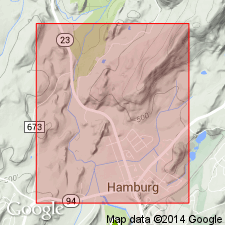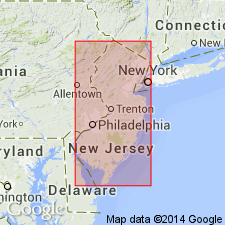
- Usage in publication:
-
- Branchville Member
- Modifications:
-
- Named
- Dominant lithology:
-
- Dolomite
- Chert
- Shale
- AAPG geologic province:
-
- Appalachian basin
Summary:
Branchville Member named and assigned to Epler Formation. Consists of gray fine- to coarse-grained, medium- to massive-bedded, laminated dolomite with chert and shale interbeds. Contains oolites and cryptozoa. Weathers reddish brown to buff. 45 m thick at measured section. Thickness ranges to 94 m. Overlies Hope Member of Rickenbach Formation; underlies Big Springs Member of Epler Formation. Age is Early Ordovician.
Source: GNU records (USGS DDS-6; Reston GNULEX).

- Usage in publication:
-
- Branchville Member
- Modifications:
-
- Areal extent
- AAPG geologic province:
-
- Appalachian basin
Summary:
Nomenclature in this report follows Markewicz and Dalton (1977) who divided the Epler into (ascending) Branchville, Big Springs, and Lafayette Members in New Jersey. The Branchville contains two distinct lithic units. The lower unit ranges from 0 to 50 feet and is a variable sequence of very fine to coarse-grained, light- to dark-gray, medium-bedded to massive dolomite with some distinctly laminated beds. Chert, shale, oolites, and cryptozoa also common. Upper unit is 150 to 200 feet thick and consists of a very fine- to fine-grained, medium- to dark-gray, massive, finely laminated dolomite. Includes some thin, siliceous to shaly interbeds similar to those of the Big Springs Member. Laminae stand out in relief on weathered surfaces.
Source: GNU records (USGS DDS-6; Reston GNULEX).
For more information, please contact Nancy Stamm, Geologic Names Committee Secretary.
Asterisk (*) indicates published by U.S. Geological Survey authors.
"No current usage" (†) implies that a name has been abandoned or has fallen into disuse. Former usage and, if known, replacement name given in parentheses ( ).
Slash (/) indicates name conflicts with nomenclatural guidelines (CSN, 1933; ACSN, 1961, 1970; NACSN, 1983, 2005, 2021). May be explained within brackets ([ ]).

